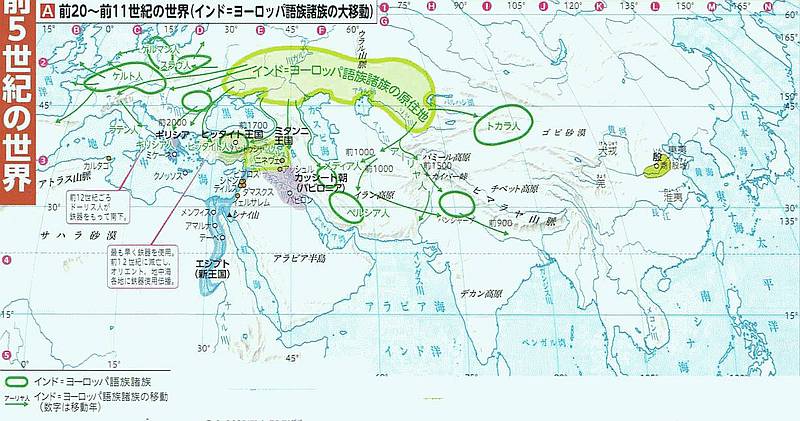おそらく紀元前3300年以降のある段階で,ウクライナやカザフスタンのステップ地帯に住まっていた印欧祖語の話し手たちの一部が,その故地を離れ,ユーラシア大陸の広い領域へと移動を開始した.彼らは数千年の時間をかけて,東方へは現在の中国の新疆ウイグル自治区まで,南方へはイランやインドまで,西方へはヨーロッパ,そして北大西洋の島まで,広く散っていくことになった.動きがとりわけ活発化したのは紀元前2千年紀のことと考えられ,以降,歴史的に同定される諸民族や諸国家の名前がユーラシア大陸のあちらこちらで確認されるようになる.トカラ人,アーリア人,ペルシア人,メディア人,ミタンニ王国,ヒッタイト王国,ギリシア人,ケルト人,ゲルマン人,スラヴ人等々.
『最新世界史図説 タペストリー』の p.4 より「前20?前11世紀の世界(インド=ヨーロッパ語族諸族の大移動)」と題する地図が,とても分かりやすい(関連して「#637. クルガン文化と印欧祖語」 ([2011-01-24-1]) の地図も参照).

上で挙げた紀元前3300年という大移動開始に関係する年代は,印欧祖語に再建される農業や牧畜に関する語彙と,そのような産業の考古学的な証拠とのすり合わせから,およそはじき出される年代である.とりわけ重要なキーワードは「車輪」である.というのは,こちらのスライドや「#166. cyclone とグリムの法則」 ([2009-10-10-1]),「#1217. wheel と reduplication」 ([2012-08-26-1]) でみたように「車輪」を表わす印欧祖語が確かに再建されており,また車輪そのものの出現が考古学的に紀元前4千年紀の後期とされていることから,印欧祖語の分化の上限が決定されるからだ.Fortson (38) がこう述べている.
Based on the available archaeological evidence, the addition of wheeled vehicles to this picture allows us to narrow the range to the mid- or late forth millennium: the earliest wheeled vehicles yet found are from c. 3300--3200 BC. If one adds a century or two on that figure (on the assumption that the actual invention of wheeled vehicles predates the earliest extant remains), that means the latest stage of common PIE (the state directly reachable by reconstruction and before any of the future branches separated) cannot have been earlier than around 3400 BC.
比較言語学と考古学のコラボにより,太古の昔の言語分化と民族大移動の年代が明らかにされ得るというエキサイティングな話題である.
・ 川北 稔・桃木 至朗(監修) 帝国書院編集部(編) 『最新世界史図説 タペストリー』16訂版,帝国書院,2018年.
・ Fortson IV, Benjamin W. Indo-European Language and Culture: An Introduction. Malden, MA: Blackwell, 2004.